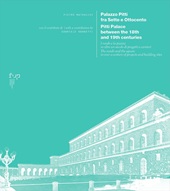Palazzo Pitti fra Sette e Ottocento : i rondò e la piazza in oltre un secolo di progetti e cantieri = Pitti Palace between the 18th and 19th centuries : the rondò and the square in over a century of projects and building sites
152 p. : ill. (some col.)
Includes bibliographical references and index.
Il tema della piazza viene affrontato a partire dall'antefatto, ovvero dalle particolari condizioni orografiche in cui è sorto il primo nucleo di palazzo Pitti, sorto tra due costoni rocciosi che ne hanno determinato l'orientamento e la posizione a margine della Firenze d'oltre Arno. Dopo numerose proposte elaborate senza esiti tra i secoli XVI e XVII, con il progetto di Giuseppe Ruggieri, si costruisce (1764-1765) il rondò delle Carrozze, dotato di una loggia e una terrazza antistante ad arco di cerchio. Si trova così una soluzione per la piazza che sorge su un piano notevolmente inclinato dell'ultima propaggine a valle della collina di Boboli.
La ricerca ripercorre le vicende dei cantieri che si susseguono dal XVIII secolo fino all'intervento di Pasquale Poccianti e alla successiva definizione del torrino del rondò di Bacco che conduce alla Galleria Palatina, mettendone in luce il complesso percorso di proposte e varianti che si sono susseguite nel tempo, attuando anche rilevanti cambiamenti di parti già eseguite. Pietro Matracchi è architetto e professore associato presso il Dipartimento di Architettura dell'Università di Firenze, dove è docente di Restauro Architettonico dal 2002. Ha insegnato la stessa disciplina presso gli Atenei di Pisa e Perugia. È stato membro del Consiglio Direttivo (2021-2023) della Società Italiana per il Restauro dell'Architettura (SIRA) [Testo dell'editore].
The theme of the square is approached by considering its backstory, namely the specific orographic conditions under which the first core of the Pitti Palace was built, standing between two rocky ridges that determined its orientation and position on the edge of Florence beyond the Arno.After numerous unsuccessful elaborate proposals between the 16th and 17th centuries, the Rondò delle Carrozze was built (1764-1765) to Giuseppe Ruggieri's design and equipped with a loggia and a terrace in front of it in the form of a circular arch. Thus, a solution was found for the square,which stands on a considerably sloping plane on the bottommost incline of the Boboli hill.
The research traces the events of the succession of construction sites from the 18th century up to Pasquale Poccianti's intervention and the subsequent definition of the turret del Rondò di Bacco leading to the Palatine Gallery. It highlights the complex proposals and variants that followed one another over time, also resulting in significant changes to parts that had already been built. Pietro Matracchi is an architect and an associate professor of Architectural Restoration at the University of Florence's Architecture Department. He has also taught Architectural Restoration at the Universities of Pisa and Perugia. He was a member of the Board of Directors of the SIRA (2021-2023), the Italian Society for Architectural Conservation/Restoration [Publisher's text].
Text in Italian and English.
-
Information


